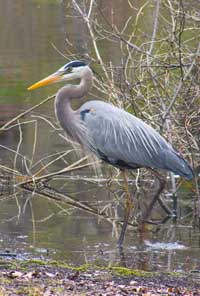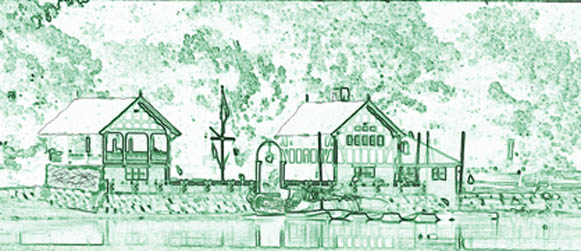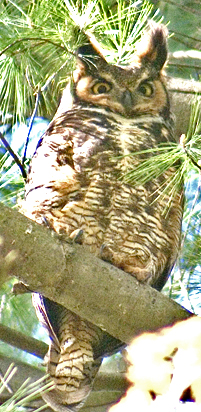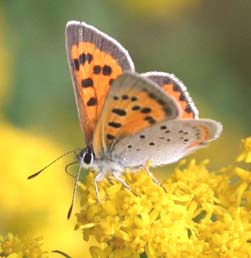|
FRIENDS OF JAMAICA POND 36 Perkins St., PO Box 300040, Jamaica Plain, MA 02130-0030 Gerry Wright, Founder and President Telephone: 617-524-7070 Email: FrederickLawOlmsted@yahoo.com TTY/MA
RELAY 800-439-2370 |
||||||||||||
|
|
||||||||||||
 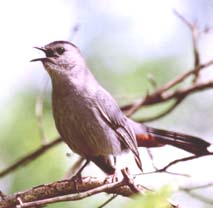    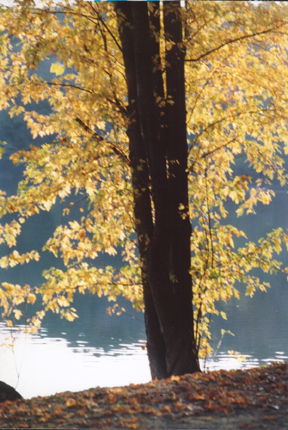  "Let it be not for present use and delight alone, but let it be of such a work that our descendents will thank us for it." Frederick Law Olmsted |
Environmental Emerald
Necklace Fungi (Coming Soon) Boston's
Emerald Necklace Great
Blue Herons by Stephen Baird Great Blue Heron - Ardea herodias Great
Blue Herons are common in the Emerald Necklace and can be seen wading
and hunting for fish, frogs and mice near or in the water at Franklin
Park, Forest Hills
Cemetery, Arnold Arboretum, Jamaica Pond, Olmsted Park and the Muddy
River. Herons are large majestic birds which have inspired stories, myths and legends
since ancient Egypt. See references below.
Adult birds grow to 3-4 feet in size with a 5-6 foot wingspan and weigh 5-7 pounds. Males are larger than the female. Song is harsh low “Cronk” when disturbed. They have many other calls. See references below. Life
span is 15 years in the wild. About seventy percent of young birds die
in the first year. Oldest known Great Blue Heron was 23 years old. This
Great Blue Heron caught a very big hornpout catfish in Leverett Pond in
Olmsted Park.
I watched it as it repeatedly speared the fish with its razor
sharp bill and attempted to swallow the fish whole head first for over
an hour. Hornpout have very sharp spiney fins. A dangerous meal for a Great Blue Heron. Great Blue
Herons have died because they swallowed prey that was to large for
their long S shaped necks and internal intestinal systems. Click on
images to see larger versions. Great Blue Herons conduct courtship during March by exchanging nest branches, clicking beaks and body movements. Usually
lay 2-6 blueish eggs in colonies of 5-300 nests in tall trees called
herones. The incubation by both male and female lasts around 30 days
and eggs hatch during April and May. Young herons fledge in 8
weeks. Great Blue Herons mate with different partners each year. Solitary hunters and primarily eat fish, frogs and reptiles, but also will eat insects, mice, rats and birds. Great
Blue Herons will migrate south to open water during the winter.
Several hardy individual Great Blue Herons have spent the entire winter in the
Emerald Necklace Parks. Fun Facts: Swallow prey whole and have choked to death from eating prey that was to large Kills prey by using long sharp beak as a spear Regurgitates foods for young Can fly 20-30 miles per hour “Grande Héron ” and “Garza morena” are the French and Spanish names for Great Blue Herons
References and Links USGS bird identification and
breeding atlas Great Blue Heron web page: HERE
( Gough, G.A., Sauer, J.R., Iliff, M. Patuxent Bird Identification
Infocenter. 1998. Version 97.1. Patuxent Wildlife Research Center,
Laurel, MD) Cornell University's
Ornithology Department on line field guide page on the Great Blue Heron
with sample song clip HERE University of Michigan site
on the Great Blue Heron with sample sound clip HERE John James Audubon's Birds of America,
Great Blue Herons detailed original 1840 observation text and paintings on
Audubon.org. HERE 36
Perkins St., PO Box
300040, Jamaica Plain, MA 02130-0030 Gerry Wright, Founder
and
President Telephone:
617-524-7070 Email: FrederickLawOlmsted@yahoo.com TTY/MA
RELAY 800-439-2370
Class Room:
Education
Projects

